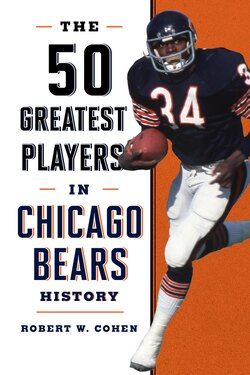Читать книгу The 50 Greatest Players in Chicago Bears History - Robert W. Cohen - Страница 8
На сайте Литреса книга снята с продажи.
FACTORS USED TO DETERMINE RANKINGS
ОглавлениеIt should come as no surprise that selecting the 50 greatest players ever to perform for a team with the rich history of the Chicago Bears presented quite a challenge. Even after narrowing the field down to a mere 50 men, I still needed to devise a method of ranking the elite players that remained. Certainly, the names of Walter Payton, Dick Butkus, Gale Sayers, Mike Singletary, Bronko Nagurski, and Brian Urlacher would appear at, or near, the top of virtually everyone’s list, although the order might vary somewhat from one person to the next. Several other outstanding performers have gained general recognition through the years as being among the greatest players ever to wear a Bears uniform, with Sid Luckman, Bill George, Mike Ditka, and Dan Hampton heading the list of other Bears icons. But, how does one compare players who lined up on opposite sides of the ball with any degree of certainty? Furthermore, how does one differentiate between the pass-rushing and run-stopping skills of linemen such as Doug Atkins and Richard Dent and the ball-hawking skills of defensive backs such as Gary Fencik and Charles Tillman? And, on the offensive end, how can a direct correlation be made between the contributions made by standout lineman Stan Jones and skill position players such as Rick Casares and Gale Sayers? And then there are early greats Bronko Nagurski and Dan Fortmann, both of whom starred on both sides of the ball for the Bears throughout their respective careers. After initially deciding whom to include on my list, I then needed to determine what criteria I should use to formulate my final rankings.
The first thing I decided to examine was the level of dominance a player attained during his time with the Bears. How often did he lead the NFL in a major statistical category? Did he ever capture league MVP honors? How many times did he earn a trip to the Pro Bowl or a spot on the All-Pro Team?
I also chose to assess the level of statistical compilation a player achieved while wearing a Bears uniform. I reviewed where he ranks among the team’s all-time leaders in those statistical categories most pertinent to his position. Of course, even the method of using statistics as a measuring stick has its inherent flaws. Although the level of success a team experiences rushing and passing the ball is impacted greatly by the performance of its offensive line, there really is no way to quantifiably measure the level of play reached by each individual offensive lineman. Conversely, the play of the offensive line affects tremendously the statistics compiled by a team’s quarterback and running backs. Furthermore, the NFL did not keep an official record of defensive numbers such as tackles and quarterback sacks until the 1980s (although the Bears kept their own records prior to that). In addition, when examining the statistics compiled by offensive players, the era during which a quarterback, running back, or wide receiver competed must be factored into the equation.
To illustrate my last point, rule changes instituted by the league office have opened up the game considerably the last two decades. Quarterbacks are accorded far more protection than ever before, and officials have also been instructed to limit the amount of contact defensive backs are allowed to make with wide receivers. As a result, the game has experienced an offensive explosion, with quarterbacks and receivers posting numbers players from prior generations rarely even approached. That being the case, one must place the numbers Jay Cutler compiled during his time in the Windy City in their proper context when comparing him to Hall of Fame signal-caller Sid Luckman. Similarly, the statistics posted by Brandon Marshall and Alshon Jeffery must be viewed in moderation when comparing them to previous Bears wideouts Ken Kavanaugh and Harlon Hill.
Other important factors I needed to consider were the overall contributions a player made to the success of the team, the degree to which he improved the fortunes of the club during his time in Chicago, and the manner in which he impacted the team, both on and off the field. While the number of championships and division titles the Bears won during a player’s years with the team certainly factored into the equation, I chose not to deny a top performer his rightful place on the list if his years in the Windy City happened to coincide with a lack of overall success by the club. As a result, the names of players such as Doug Buffone and Matt Forte will appear in these rankings.
One other thing I should mention is that I only considered a player’s performance while playing for the Bears when formulating my rankings. That being the case, the names of Wilber Marshall and Khalil Mack, both of whom had many of their finest seasons with other teams, may appear lower on this list than one might expect. Meanwhile, the names of Hall of Fame players Bobby Layne and Alan Page are nowhere to be found.
Having established the guidelines to be used throughout this book, the time has come to reveal the 50 greatest players in Bears history, starting with number 1 and working our way down to number 50.
